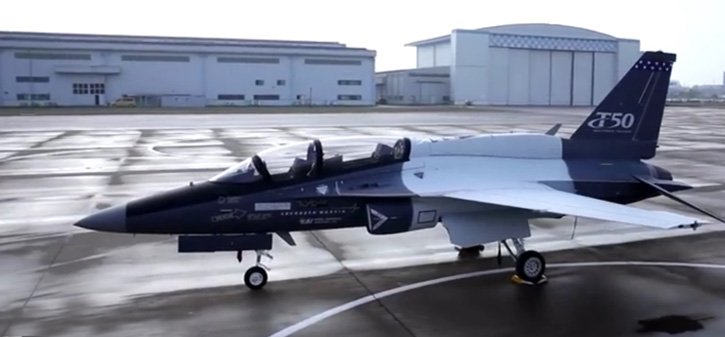New T-X Airplanes Would Add $1B To Trainer Bill: Lockheed
Posted on

UPDATED: Adds Force Comment
WASHINGTON: Lockheed Martin is pressing the Air Force to change how it evaluates T-X bids, arguing that new aircraft will cost the service close to $1 billion more over six years and delay Initial Operating Capability by several years.
The calculus behind this assertion appears pretty simple. New aircraft require structural testing, operational tests and they usually encounter unexpected problems that slow progress. Lockheed can get its T-50 trainer offering ready by 2022 or earlier, Lockheed’s Rob Weiss, VP at Skunk Works, told a pair of reporters. A new aircraft couldn’t be ready before 2026 at the earliest, he says a Lockheed analysis concludes.
Now the Boeing-Saab T-X team argues that their new aircraft being offered for the T-X is already in production. “It is a production jet at this stage,” Darryl Davis, president of Boeing’s Phantom Works, said on the day the two companies unveiled their offering. He was standing in front of a second jet already being subjected to structural proof tests. The two companies are building a plane with very little touch labor and are using advanced adhesives, 3-D printing (additive manufacturing to the faithful) and other techniques to “break the cost curve,” Davis told reporters after the unveiling this morning. Bending the cost curve is, of course, Air Force Secretary Deborah Lee James’ effort to rein in development and procurement costs.

Boeing T-X entry at unveiling
Of course, the Boeing T-X has not flown yet. It’s supposed to by the end of this year, which is impressive. But a plane that has not flown yet is a plane facing uncertainties. Northrop Grumman and BAE Systems have teamed to build a new aircraft for the training program as well. Raytheon is working with Leonardo (formerly Finnmeccanica) to offer a version of an existing aircraft to compete for the program.
I asked Weiss if he accepted Davis’ assertion that the Boeing plane is a production jet. The plain answer: no.
“Both are prototypes,” he replied, referring to Boeing and Northrop. “Our competitors want to characterize these as production planes but they are not.” The other companies’ offerings are X planes and improvements to production such as those outlined by Boeing “do not lead to a reduction in the EMD lifespan.”
The delays to getting to IOC Lockheed says will occur with a new plane will worsen the Air Force’s growing pilot shortage, Weiss said. The combination of high fidelity simulators and the new trainer would allow the Air Force to train pilots at a faster rate. The T-X is designed to allow pilots to train for flying fifth-generation aircraft like the F-35 and F-22. Currently, pilots fly ancient T-38 trainers and then have to work their way up through the hierarchy of aircraft before they fly advanced aircraft. Weiss noted that several hundred F-35A fifth generation aircraft will be ready before the T-X.
UPDATE BEGINS The Advanced Pilot Training (T-X) program will help us close the vital training gaps between fourth and fifth generation fighter aircraft capabilities. By 2031, more than 60 percent of the Combat Air Force fleet will be comprised of 5th generation aircraft, which requires a modern and capable training platform with capabilities beyond that currently available in the T-38C,” Capt. Michael Hertzog, Air Force spokesman, wrote in an email.UPDATE ENDS
A key issue for Lockheed, Weiss made clear, is getting the Air Force to include credit for its lower costs and shorter schedule in the RFP criteria. He said they’ve discussed this with the service and haven’t received any indication that these factors will be included in the RFP. The RFP is due in December.
UPDATE BEGINSHertzog made it clear the Air Force is, at least, listening to Lockheed and the other competitors. “We’re continually applying the acquisition strategy and tactics of our “Bending the Cost Curve” initiative, and we are confident our continuous dialogue with industry is producing a strong cost and capability balance,” Hertzog writes. “We’re on track for RFP release in the coming months, and moving forward with this program will ensure we are effectively leveraging competition to guarantee we get a reasonable price for the warfighter and the taxpayer.”UPDATE ENDS
If Lockheed or Raytheon eventually win, this program may well set a standard for industry in its dealings with the Air Force. Should upgraded systems save enough money and get useful capabilities to the service in significantly shorter times, we may well see — after 20 years of talk about it — true commitment to spiral development or upgrades or whatever you want to call it. It may also, given that both Lockheed’s and Raytheon’s aircraft boast significant foreign content and design, begin to break the back of the curse that was placed on foreign aircraft by the bitter fight over the airborne tanker between Boeing, Northrop and Airbus. We’ll see.
Subscribe to our newsletter
Promotions, new products and sales. Directly to your inbox.
